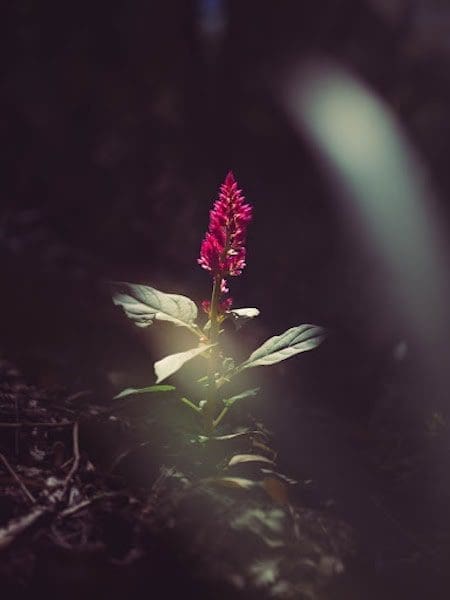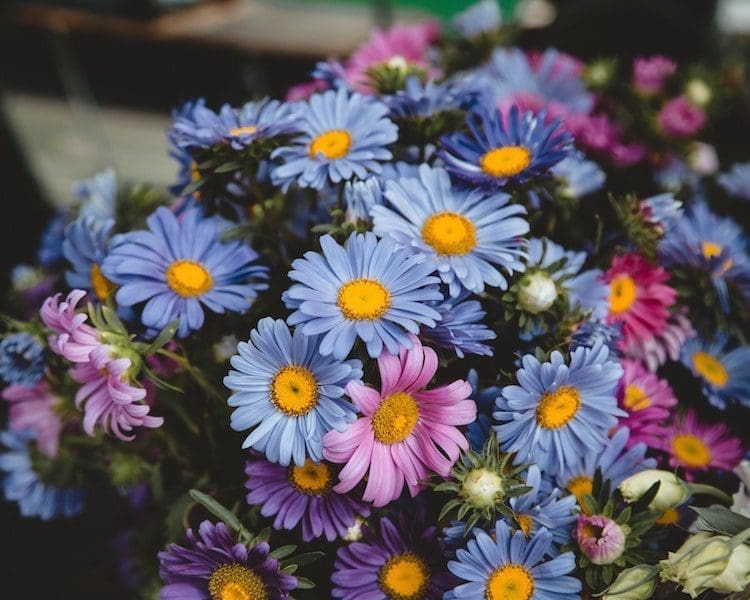Ah, flowers. The flowers that can brighten your day, the flowers that can put a smile on your face, and the flowers that you often purchase at Fig & Bloom for loved ones as gifts. But what is it about flowers that cause us to be so attracted to them? Why do we find flowers beautiful – not just visually but also psychologically? Today we are going to explore this question – why do we buy flowers? Hopefully, the answers will shed some light on why flowers are so appealing to humans of both genders in terms of both aesthetics and emotion.
Flower Petals
The reason behind flower petal colours is their function; they attract pollinators such as bees or butterflies. For example, blue petals tend to be found on plants that need cross-pollination from different flowers, whereas white flowers tend to be found on plants that pollinate by themselves and so do not require the aid of outside insects.
But why are flowers so brightly coloured in comparison to leaves or other parts of plants? The reason is that flowers are designed as a mate attractor for pollinators – if they didn’t stand out then the plant would rely on luck for its pollen to fall onto another flower. However, flowers wouldn’t work as well if they were all one colour because it would be hard for an insect to tell which flower was healthy or unhealthy – thus explaining diversity in flowers’ colours.
However, while humans do tend to care about plant reproduction; we primarily want flowers for aesthetic reasons. But what exactly causes flowers to be beautiful in the first place?

Flower Design
Well, flowers are often symmetrical due to their growth patterns. In addition, flowers tend to have a high contrast between petals and backgrounds which is attractive for humans – this is called the “contrast principle”. For example, imagine a green flower in front of a blue background; it appears less colourful than if the same flower was put in front of a red background.
People often look for fresh flower arrangements that can elevate the aesthetic appeal of any room. The vibrant colors and natural symmetry of flowers create a sense of balance and harmony, making them a timeless choice for enhancing spaces.
Thus, flowers such as roses or sunflowers are more eye-catching because they contain so much yellow, orange and red light reflecting off their petals. This explains why flowers have evolved into shapes that we find aesthetically pleasing and also why many movie sets choose flowers with vibrant colours: it’s just easier to film!
Flower Genes
However, flowers are also packed with genes that we cannot see. Some flowers may have a scent; others may have nectar to attract pollinators, while flowers such as the tulip contain a chemical called “gardenal” which can harm insects but not humans. These scents and chemicals often cause flowers to be described as having a “pleasant aroma”.
But what exactly causes flowers to smell nice? By inhaling flowers, you tend to dilate your blood vessels in order to get more oxygen into your lungs – this is why some people use flowers for nervousness, stress or anxiety – although we would recommend meditation instead!
However, when you’re using flowers for their aroma you will also be increasing the amount of carbon dioxide (CO2) in your blood; flowers tend to increase the production of CO2 by 40% due to their photosynthesis (it’s no wonder that flowers are considered a source of life!). Thus flowers will release some of this extra carbon dioxide and in turn, produce a scent.
Flower Colours
As well as having pleasant scents, flowers also have vibrant colours which can cause an emotional response within people: flowers evoke positive emotions such as happiness or love. Flowers go hand-in-hand with Valentine’s Day for this exact reason: they make us feel good about ourselves and others! This is because flowers are associated with certain human emotions or activities.
For example, red roses are often used for romance. Imagine trying to woo someone back with a bunch of lilac flowers! This is because flowers have evolved to produce flowers in the same colour as their background, thus making them stand out. For example, foxgloves are often red flowers that grow on a green grassy background; they would be much less noticeable if they were bright blue!
Flower Emotions
However, flowers can also cause negative emotions due to our associations with them. One example of this is chrysanthemums: while they may be associated with cheerfulness and joy in other parts of the world, in Japan flowers such as chrysanthemums can symbolize death and funerals. This is because these flowers originally come from China where dead people had been buried beneath them – it is no surprise then that Japanese people associate flowers such as chrysanthemums with death!
Flowers Medicinal Uses
But flowers are not just used for aesthetic purposes – flowers have also been used to cure people of various diseases. This is because flowers contain certain chemicals which help fight against bacteria; flowers can also be consumed for medicinal purposes. For example, people who suffer from hay fever can be cured by flowers such as marigolds or lavender flowers.
Flowers have evolved to produce chemicals that either help themselves, their offspring or pollinators! However, flowers need to be careful: if they are too unpleasant then no one will visit them and the flower will die (this might seem dramatic – but imagine how lonely it would feel if you were a sunflower in a field full of daisies!).
Thus some flowers become “deceit flowers” such as flowers that appear poisonous in order to attract insects. These flowers are harmless and actually produce nectar, while flowers like the fly orchids trick flies into thinking that they need to eat from the flower in order to mate with it – thus flowers have evolved for sexual purposes!
Flowers History
Flowers have evolved over millions of years: flowers have been around since at least 140 million years ago (although flowers may have existed before this date) when flowering plants first appeared on Earth. In addition, flowers also had a profound impact upon our evolution by producing fruits which can be eaten by animals but these fruits usually contain the seeds of that flower so that their offspring can spread across the world. Thus flowers are truly amazing!


